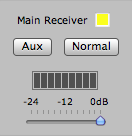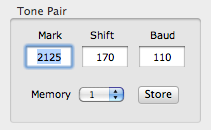
cocoaModem ASCII Radioteletype Interface
Kok Chen, W7AY
[w7ay (at) arrl
(dot) net]
Last updated: January 30, 2010
Index (User's Manual - ASCII Radioteletype Interface)
General Information
Aural Monitor
Accessibility (Incremental Speak and Voice Assist)
Macros
RTTY Interfaces
PSK Interface
MFSK Interface
Hellschreiber Interface
CW Interface
ASCII Interface
ASCII Interface
SITOR-B Receiver
HF-FAX Receiver
Synchronous AM Receiver
Versions
Part II
ASCII Interface
Introduction
cocoaModem implements a wideband interface that allows you to operate ASCII Radioteleype within a waterfall's passband.
ASCII Radioteletype ("ASCII" for short) uses the same modulation methods (frequency shift keying) as RTTY. The main difference is that ASCII character encoding is used in place of Baudot character encoding.
Baudot consists of 5 bit codeword. Since 32 states are insufficient to encode letters, numbers and punctiations, the Baudot code is partitioned into two tables. Two special non-printing characters, one character is sent to shift the decoder into the "letters" (LTRS) table and the other character is sent to shift the decoder into the "figures" (FIGS) table which include numbers and punctuations. When a LTRS or FIGS character is misdecoded (or some other character is misdecoded into a LTRS or FIGS character), subsequent characters can be wrong until the proper LTRS/FIGS state is again restored.
Standard ASCII consists of 128 usable codewords, and not only can it uniquely encode letter, numbers and punctuations in the same table, the table is large enough includes both upper case and lower case alphabets.
Unlike Baudot, ASCII includes a backspace character. Like PSK31, you can correct typing errors by backspacing over previous characters in ASCII.
Operation
The ASCII user Interface in cocoaModem is derived from the Wideband RTTY Interface. Please refer to the Wideband RTTY section.
A common settings for ASCII operations are
Shift: 170 Hz
Baud rate: 110 baud
Character length: 7 bits
Stop bits: 2
As in the Wideband RTTY Interface, the Shift and Baud rate settings appear in the Tone Pair box within the panel that is opened using AUX button.


The character length and stop bits are set in the transmit
config window:

Next (SITOR-B)